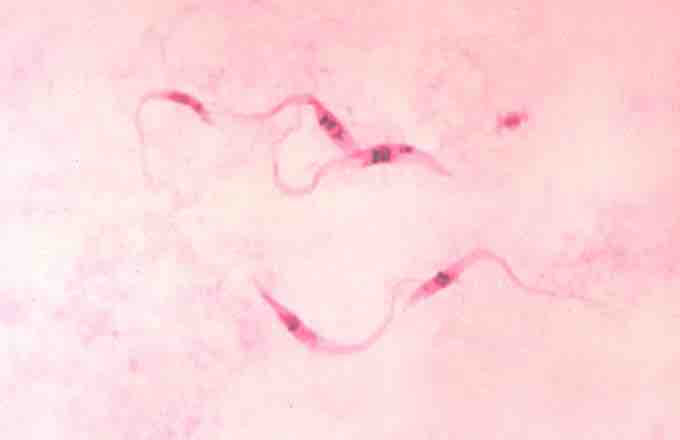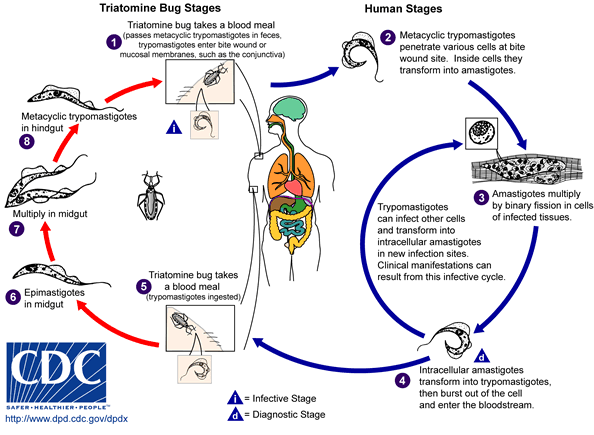Chagas disease, also known as American trypanosomiasis, is caused by the parasite Trypanosoma cruzi. It is transmitted to humans via the reduviid bug (the "kissing bugs"), and is therefore characterized as a zoonotic disease.

Trypanasoma cruzi
Chagas disease is similar to African sleeping sickness which is caused by the African trypanosome. The risk factors for Chagas disease include living where reduviid bugs live, including areas of Central and South America. In addition, it is possible to obtain Chagas via blood transfusion from an individual with the active disease.
Reduviid bug
In Chagas-endemic areas, the main mode of transmission is through an insect vector called a triatomine or reduviid bug.The bugs emerge at night, when the inhabitants are sleeping. Because they tend to feed on people's faces, triatomine bugs are also known as "kissing bugs." After they bite and ingest blood, they defecate on the person. Triatomines pass T. cruzi parasites (called trypomastigotes) in feces left near the site of the bite wound.
The reduviid bug itself becomes infected by feeding on the blood of an already-infected person or animal. The bugs are nocturnal, emerge at night and typically feed on an individual's face. The bug then proceeds to defecate on the person, passing Trypanosoma cruzi parasites in its feces in posterior station infection. These parasites surround the bite wound and, when the bite is scratched, the parasites are able to pass into the host. The reduviid bud often bites the tender skin around the eyes, leaving a swollen bump called a chagoma or Ramona's sign.
Romaña's sign
The most recognized marker of acute Chagas disease is called Romaña's sign, which includes swelling of the eyelids on the side of the face near the bite wound or where the bug feces were deposited or accidentally rubbed into the eye.
At this specific stage, the parasites are referred to as trypomastigotes, and these invade the host cells and differentiate into intracellular amastigotes where they continue to multiply by binary fission. These amastigotes then differentiate into trypomastigotes which circulate into the bloodstream. At this time, if the infected individual is re-bitten by a reduviid bug, the cycle will start again.

Lifecycle of Trypanasoma cruzi
Chagas disease can be characterized by two phases: acute and chronic. The acute phase is characterized by mild symptoms which include fever, swelling of an eye or area surrounding the insect bite. However, the acute phase will enter remission and then, over time, additional symptoms will develop that include: constipation, gastrointestinal issues, heart failure, abdominal pain and difficulties swallowing.
Chagas disease can be characterized by two phases: acute and chronic. The acute phase is presents with mild symptoms which include: fever, swelling of an eye and/or the area surrounding the insect bite.
The acute phase will then enter remission and, over time, additional symptoms will develop that include: constipation, gastrointestinal issues, heart failure, abdominal pain and difficulties swallowing. It can sometime take upwards of 20 years from the time of infection for these later heart and digestive issues to present. American trypanosomiasis causes megacolon and megaesophagus and an enlarged heart in pediatric patients and is very serious.